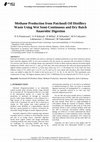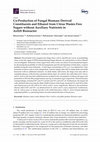Papers by Mohammad Taherzadeh

Advances in engineering research, 2021
Patchouli oil distillery waste (PODW) was used as a substrate for methane production in wet semi-... more Patchouli oil distillery waste (PODW) was used as a substrate for methane production in wet semi-continuous and dry batch anaerobic digestion (AD). In wet semi-continuous AD, the system was operated with recirculation of effluent. Two reactors with 300 mL of working volume were operated for 45 days in three moderate stepwise-increased organic loading rates (OLR), which were 0.5, 1, and 2 g VS/(L.day). Wet semi-continuous AD with recirculation produced the highest methane production at OLR of 1 g VS/(L.day), which was 13.71 ± 2.28 (Nml/g VS). In dry batch AD, three different values of VS, which were 1.5 g VS; 3 g VS; and 6 g VS, were mixed with inoculum, after which distilled water was added to adjust the TS content in the reactor up to 17; 12; 20; 15; 26; and 21%. The experiments were conducted for 47 days. The highest methane yield of 13.87 ± 0.99(Nml/g VS) was obtained with TS 17% of 1.5 g VS.
Biodiversitas, Jul 23, 2019
Fractions of sulfuric acid-pretreated wheat straw, i.e. solid, liquid, and a mixture of liquid an... more Fractions of sulfuric acid-pretreated wheat straw, i.e. solid, liquid, and a mixture of liquid and solid were used as substrates in simultaneous saccharification and fermentation (SSF) process to produce ethanol. The bioconversion was performed by Monascus purpureus CBS 109.07 and Fusarium venenatum ATCC 20334. The highest ethanol yields from solid, liquid and a mixture of solid and liquid fractions by M. purpureus CBS 109.07 were 0.36, 0.41, and 0.37 g/g glucose, respectively. The corresponding values by F. venenatum ATCC 20334 were 0.21, 0.54, 0.35 g/g glucose, respectively.

Elsevier eBooks, 2017
Bioethanol, one of the most promising technological advancements of the century, has been widely ... more Bioethanol, one of the most promising technological advancements of the century, has been widely acclaimed for being produced from diversified origins. Production of bioethanol from food grains (as in Brazil or the United States) is, however, frequently criticized in the food versus fuel debate. Several research studies across the globe, investigating the potential use of various renewable resources (such as waste biomass), have resulted in the emergence of second- and/or third-generation bioethanol processes. This chapter attempts to consolidate various aspects of bioethanol production from solid-waste biomass. Waste biomass of lignocellulosic and starch-based origin, such as municipal solid waste, industrial waste (waste paper or coffee residues), livestock manure, and agricultural waste (wood biomass and agricultural crop residues), are reviewed for their potential to produce ethanol. This chapter describes the feedstock prospects, process technologies, and current research and industrial developments.

International Journal of Molecular Sciences, Feb 26, 2016
The potential of two zygomycetes fungi, Mucor indicus and Rhizopus oryzae, in assimilating citrus... more The potential of two zygomycetes fungi, Mucor indicus and Rhizopus oryzae, in assimilating citrus waste free sugars (CWFS) and producing fungal chitosan, oil, and protein as well as ethanol was investigated. Extraction of free sugars from citrus waste can reduce its environmental impact by decreasing the possibility of wild microorganisms growth and formation of bad odors, a typical problem facing the citrus industries. A total sugar concentration of 25.1 g/L was obtained by water extraction of citrus waste at room temperature, used for fungal cultivation in shake flasks and airlift bioreactor with no additional nutrients. In shake flasks cultivations, the fungi were only able to assimilate glucose, while fructose remained almost intact. In contrast, the cultivation of M. indicus and R. oryzae in the four-liter airlift bioreactor resulted in the consumption of almost all sugars and production of 250 and 280 g fungal biomass per kg of consumed sugar, respectively. These biomasses correspondingly contained 40% and 51% protein and 9.8% and 4.4% oil. Furthermore, the fungal cell walls, obtained after removing the alkali soluble fraction of the fungi, contained 0.61 and 0.69 g chitin and chitosan per g of cell wall for M. indicus and R. oryzae, respectively. Moreover, the maximum ethanol yield of 36% and 18% was obtained from M. indicus and R. oryzae, respectively. Furthermore, that M. indicus grew as clump mycelia in the airlift bioreactor, while R. oryzae formed spherical suspended pellets, is a promising feature towards industrialization of the process.
Dilute phosphoric acid pretreatment of wheat straw for ethanol production using edible fungi

Applied Biochemistry and Biotechnology, Jun 8, 2017
Integration of wheat straw for a biorefinery-based energy generation process by producing ethanol... more Integration of wheat straw for a biorefinery-based energy generation process by producing ethanol and biogas together with the production of high-protein fungal biomass (suitable for feed application) was the main focus of the present study. An edible ascomycete fungal strain Neurospora intermedia was used for the ethanol fermentation and subsequent biomass production from dilute phosphoric acid (0.7 to 1.2% w/v) pretreated wheat straw. At optimum pretreatment conditions, an ethanol yield of 84 to 90% of the theoretical maximum, based on glucan content of substrate straw, was observed from fungal fermentation post the enzymatic hydrolysis process. The biogas production from the pretreated straw slurry showed an improved methane yield potential up to 162% increase, as compared to that of the untreated straw. Additional biogas production, using the syrup, a waste stream obtained post the ethanol fermentation, resulted in a combined total energy output of 15.8 MJ/kg wheat straw. Moreover, using thin stillage (a waste stream from the first-generation wheat-based ethanol process) as a co-substrate to the biogas process resulted in an additional increase by about 14 to 27% in the total energy output as compared to using only wheat straw-based substrates.
Airlift bioreactors are generally considered to be better alternatives for cultivation of filamen... more Airlift bioreactors are generally considered to be better alternatives for cultivation of filamentous fungi in comparison to stirred-tank bioreactors or bubble columns bioreactors. The reason for t ...

Purpose of the work:The present study reports the application of using dilute phosphoric acid for... more Purpose of the work:The present study reports the application of using dilute phosphoric acid for pretreatment of wheat branbiomass and its subsequent use as an ethanol fermentation substrate for edible fungi, Neurospora intermedia inbench scale (4.5L) and pilot airlift (26L) reactors.Approach:The optimized pretreatment conditions to release maximum sugar and minimum inhibitor concentrations weredetermined using a statistically modelled experimental setup. The dilute acid pretreatment was scaled up withthe validation of lab results in a biorefinery demo plant (BDP) at Svensk Etanolkemi AB – SEKAB (Ornskoldsvik,Sweden). The structural and physiological changes in the bran biomass during the pretreatment process werealso studied. Bench scale and pilot scale enzymatic hydrolysis of the pretreated biomass and subsequent ethanolfermentation using edible ascomycetes fungi, N. intermedia were studied using airlift reactors.Scientific innovation and relevance:With the use of dilute phosphoric acid, the study put forth an alternative strategy to the current use of relativelystronger acids for lignocellulosic biomass pretreatment. The potential use of acid pretreated lignocellulosicbiomass (wheat bran) as an ethanol feedstock, together with the edible fungal cultivation is a first of its kindapproach towards a wider ‘biorefinery’ concept. Improving the co-product (DDGS) quality and ethanol yield inthe existing wheat based ethanol facilities, whereby enhancing the overall ethanol production economics formsthe ultimate aim of the study.Results:Wheat bran was subjected to dilute acid pretreatment at varying acid concentrations (0.5–3.0% w/v),temperature (150–210◦C), and reaction time (5–20 min). The interaction of multiple factors showed theoptimum pretreatment conditions at acid concentration of 1.75% (w/v), at 190◦C for 10 min. A maximum totalpolysaccharide yield of 0.27 ± 0.01 g/g dry biomass loading, corresponding to 66% of the theoretical maximumwas observed. The effect of the dilute acid pretreatment on the functional groups of the wheat bran cellulosewas determined with 78% reduction in the cellulose crystallinity index. Enzymatic hydrolysis of pretreated slurryfrom the demo plant showed 85% total theoretical yield of polysaccharides. Compared to the untreated branbiomass, an increase of 51% was observed in the ethanol yield following pretreatment, with a total ethanol yieldof 95% theoretical maximum. Similar results were also observed on scaling up the reaction volume in a benchscale (4.5L) and pilot scale (26L) airlift reactors, which will also be presented in detail.Conclusions:The present work brings out the potential of using phosphoric acid as an efficient pretreatment agent addressingthe long existing problems associated with the sulfur contamination of the feed. Additional advantages relatedto the nutritional enrichment of DDGS (at the existing wheat based ethanol facility), with the use of edibleascomycetes fungi were also achieved. However, techno-economical analyses are required to determine theactual industrial feasibility of the process.
Green chemistry and chemical engineering, Jun 29, 2015
BioMed Research International, 2016

Applied Biochemistry and Biotechnology, Apr 8, 2019
A new post-treatment method of fungal biomass after fermentation is revealed. The posttreatment s... more A new post-treatment method of fungal biomass after fermentation is revealed. The posttreatment strategy was utilized to produce pigments as an additional valuable metabolite. Posttreatment included incubation at 95% relative humidity where the effects of harvesting time, light, and temperature were studied. Pigment-producing edible filamentous fungus Neurospora intermedia cultivated on ethanol plant residuals produced 4 g/L ethanol and 5 g/L fungal biomass. Harvesting the pale biomass after 48 h submerged cultivation compared to 24 h or 72 h increased pigmentation in the post-treatment step with 35% and 48%, respectively. The highest pigment content produced, 1.4 mg/g dry fungal biomass, was obtained from washed biomass treated in light at 35°C whereof the major impact on pigmentation was from washed biomass. Moreover, post-treated biomass contained 50% (w/w) crude protein. The posttreatment strategy successfully adds pigments to pre-obtained biomass. The pigmented fungal biomass can be considered for animal feed applications for domestic animals.
Biofuel research journal, Mar 1, 2016
HIGHLIGHTS Economically viable production of 2 nd generation bioethanol cannot rely on a single... more HIGHLIGHTS Economically viable production of 2 nd generation bioethanol cannot rely on a single product. SSFF can be used for production of ethanol and biomass from wheat straw. Glucose present in the feed controlled the assimilation of xylose and acetic acid. The fungal growth rate was found not to be influenced by the feed composition. Rhizopus biomass yields of up 0.34 g/g and ethanol yields of 0.40 g/g were obtained.

Pretreatment of oil palm empty fruit bunch (OPEFB) with N-Methylmorpholine-N-oxide (NMMO) to enha... more Pretreatment of oil palm empty fruit bunch (OPEFB) with N-Methylmorpholine-N-oxide (NMMO) to enhance biogas production was investigated. The pretreatments were performed at 90 and 120ºC for 1, 3, and 5 h using three different concentrations of NMMO of 73%, 79%, and 85%. The pretreated OPEFB was subsequently anaerobically digested to produce biogas. After pretreatment, there were no significant changes of the main composition of OPEFB and the maximum total solid recovery was 92%. The amorphous phase was increased up to 78% at pretreatment condition using 85% NMMO solution for 3 h at 120oC. In general, higher concentration of NMMO and higher temperature resulted in increased amorphous form and higher biogas production. The best results of biogas production reached enhancement of methane yield of 148% compared to the untreated OPEFB and increased in digestion of 94% compared to starch as reference.

Biomass, Biofuels, Biochemicals, 2021
Abstract Successful establishment of a worldwide circular bioeconomy lies, at great extent, in es... more Abstract Successful establishment of a worldwide circular bioeconomy lies, at great extent, in establishing processes for the conversion of various industrial and municipal sidestreams, residuals, and wastes into feed, food, bio-based chemicals, and bioenergy. The diversity of materials, in terms of both amount and composition, around the world also calls for the development of a panoply of resource recovery strategies to meet country-level needs. This chapter provides an overview of biological (aerobic and anaerobic microbial methods) and thermochemical (combustion, gasification, and pyrolysis) processes with potential for the recovery of nutrients and/or their conversion into various products (e.g., electricity, heat, biofuels, biochemicals, and feed and food ingredients). The social aspects surrounding resource recovery and the limitations related to each of the described strategies are also addressed. Lastly, a discussion on integration and diversification of the considered strategies, leading potentially to faster implementation of circular processes, is provided.
Industrial Biorefineries and White Biotechnology provides a comprehensive look at the increasing ... more Industrial Biorefineries and White Biotechnology provides a comprehensive look at the increasing focus on developing the processes and technologies needed for the conversion of biomass to liquid and gaseous fuels and chemicals, in particular, the development of low-cost technologies. During the last 3-4 years, there have been scientific and technological developments in the area; this book represents the most updated information and technological perspective on the topic. * Provides information on the most advanced and innovative pretreatment processes and technologies for biomass* Covers information on lignocellulosic and algal biomass to work on the principles of biorefinery* Provides information on integration of processes for the pretreatment of biomass* Designed as a textbook for both graduate students and researchers











Uploads
Papers by Mohammad Taherzadeh